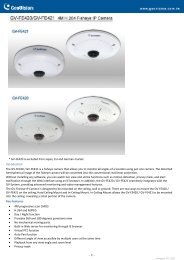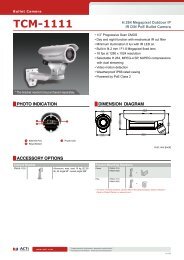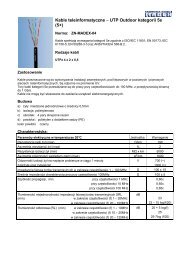- Page 1:
Powered by AcctonES3528MF-PoEFast E
- Page 5:
About This GuidePurposeThis guide g
- Page 9 and 10:
ContentsAuthorization Settings 3-85
- Page 11 and 12:
ContentsVLAN Configuration 3-218IEE
- Page 13 and 14:
ContentsAccessing the CLI 4-1Consol
- Page 15 and 16:
Contentslogging sendmail host 4-63l
- Page 17 and 18:
Contentsaaa group server 4-123serve
- Page 19 and 20:
Contentsclear ip dhcp snooping data
- Page 21 and 22:
Contentslacp 4-253lacp system-prior
- Page 23 and 24:
Contentspvlan uplink/downlink 4-323
- Page 25 and 26:
ContentsIGMP Snooping Commands 4-38
- Page 27:
TablesTable 1-1 Key Features 1-1Tab
- Page 31:
FiguresFigure 3-1 Home Page 3-2Figu
- Page 34 and 35:
FiguresFigure 3-133 802.1Q Tunnel S
- Page 36 and 37:
Figuresxxxvi
- Page 38 and 39:
1IntroductionFeatureTable 1-1 Key F
- Page 40 and 41:
1Introductionforwarding traffic bas
- Page 42 and 43:
1IntroductionSystem DefaultsThe swi
- Page 44 and 45:
1IntroductionTable 1-2 System Defau
- Page 46 and 47:
2Initial Configuration• Configure
- Page 48 and 49:
2Initial ConfigurationSetting Passw
- Page 50 and 51:
2Initial Configuration4. If network
- Page 52 and 53:
2Initial ConfigurationConfiguring A
- Page 54 and 55:
2Initial Configuration2. Enter the
- Page 56 and 57:
3Configuring the SwitchNavigating t
- Page 58 and 59:
3Configuring the SwitchMain MenuUsi
- Page 60 and 61:
3Configuring the SwitchTable 3-2 Ma
- Page 62 and 63:
3Configuring the SwitchTable 3-2 Ma
- Page 64 and 65:
3Configuring the SwitchTable 3-2 Ma
- Page 66 and 67:
3Configuring the SwitchTable 3-2 Ma
- Page 68 and 69:
3Configuring the SwitchWeb - Click
- Page 70 and 71:
3Configuring the SwitchCLI - Use th
- Page 72 and 73:
3Configuring the SwitchCLI - Enter
- Page 74 and 75:
3Configuring the SwitchUsing DHCP/B
- Page 76 and 77:
3Configuring the SwitchManaging Fir
- Page 78 and 79:
3Configuring the SwitchCommand Attr
- Page 80 and 81:
3Configuring the SwitchIf a new ima
- Page 82 and 83:
3Configuring the SwitchSaving or Re
- Page 84 and 85:
3Configuring the SwitchCLI - Enter
- Page 86 and 87:
3Configuring the SwitchConsole Port
- Page 88 and 89:
3Configuring the SwitchTelnet Setti
- Page 90 and 91:
3Configuring the SwitchConfiguring
- Page 92 and 93:
3Configuring the SwitchWeb - Click
- Page 94 and 95:
3Configuring the Switch• Severity
- Page 96 and 97:
3Configuring the SwitchWeb - Click
- Page 98 and 99:
3Configuring the SwitchWeb - Select
- Page 100 and 101:
3Configuring the SwitchCLI - This e
- Page 102 and 103:
3Configuring the SwitchDate Mode -
- Page 104 and 105:
3Configuring the Switchthe format o
- Page 106 and 107:
3Configuring the SwitchWeb - Click
- Page 108 and 109:
3Configuring the Switch• Enable A
- Page 110 and 111:
3Configuring the SwitchSpecifying a
- Page 112 and 113:
3Configuring the SwitchWeb - Click
- Page 114 and 115:
3Configuring the SwitchWeb - Click
- Page 116 and 117:
3Configuring the SwitchTable 3-4 Su
- Page 118 and 119:
3Configuring the SwitchSetting SNMP
- Page 120 and 121:
3Configuring the SwitchConfiguring
- Page 122 and 123:
3Configuring the SwitchConfiguring
- Page 124 and 125:
3Configuring the SwitchUser Authent
- Page 126 and 127:
3Configuring the SwitchConfiguring
- Page 128 and 129:
3Configuring the SwitchWeb - Click
- Page 130 and 131:
3Configuring the Switch- Confirm Se
- Page 132 and 133:
3Configuring the SwitchCLI - Specif
- Page 134 and 135:
3Configuring the SwitchCLI - Specif
- Page 136 and 137:
3Configuring the SwitchAAA Accounti
- Page 138 and 139:
3Configuring the SwitchWeb - Click
- Page 140 and 141:
3Configuring the SwitchWeb - Click
- Page 142 and 143:
3Configuring the SwitchConfiguring
- Page 144 and 145:
3Configuring the Switch• Private
- Page 146 and 147:
3Configuring the Switch5. Enable SS
- Page 148 and 149:
3Configuring the SwitchWeb - Click
- Page 150 and 151:
3Configuring the SwitchWeb - Click
- Page 152 and 153:
3Configuring the Switch• SSH Auth
- Page 154 and 155:
3Configuring the Switch• Each swi
- Page 156 and 157:
3Configuring the Switch• Re-authe
- Page 158 and 159:
3Configuring the SwitchCLI - This e
- Page 160 and 161:
3Configuring the SwitchWeb - Select
- Page 162 and 163:
3Configuring the SwitchWeb - Click
- Page 164 and 165:
3Configuring the SwitchConfiguring
- Page 166 and 167:
3Configuring the SwitchConfiguring
- Page 168 and 169:
3Configuring the SwitchDisplaying W
- Page 170 and 171:
3Configuring the Switch• Authenti
- Page 172 and 173:
3Configuring the SwitchWeb - Click
- Page 174 and 175:
3Configuring the SwitchCLI - This e
- Page 176 and 177:
3Configuring the Switch• Attribut
- Page 178 and 179:
3Configuring the SwitchCLI - This e
- Page 180 and 181:
3Configuring the SwitchConfiguring
- Page 182 and 183:
3Configuring the SwitchWeb - Specif
- Page 184 and 185:
3Configuring the SwitchConfiguring
- Page 186 and 187:
3Configuring the SwitchWeb - Specif
- Page 188 and 189:
3Configuring the SwitchWeb - Specif
- Page 190 and 191:
3Configuring the SwitchCLI - This e
- Page 192 and 193:
3Configuring the Switchother packet
- Page 194 and 195:
3Configuring the Switchaddresses ar
- Page 196 and 197:
3Configuring the Switchvalidation a
- Page 198 and 199:
3Configuring the Switch- If a DHCP
- Page 200 and 201:
3Configuring the SwitchDHCP Snoopin
- Page 202 and 203:
3Configuring the SwitchCommand Attr
- Page 204 and 205:
3Configuring the SwitchIP Source Gu
- Page 206 and 207:
3Configuring the SwitchConfiguring
- Page 208 and 209:
3Configuring the SwitchDisplaying I
- Page 210 and 211:
3Configuring the SwitchField Attrib
- Page 212 and 213:
3Configuring the Switchtrunk. If no
- Page 214 and 215:
3Configuring the SwitchCreating Tru
- Page 216 and 217:
}}3Configuring the SwitchCLI - This
- Page 218 and 219:
3Configuring the SwitchConsole#show
- Page 220 and 221:
3Configuring the SwitchConsole#show
- Page 222 and 223:
3Configuring the SwitchWeb - Click
- Page 224 and 225:
3Configuring the SwitchCLI - The fo
- Page 226 and 227:
3Configuring the SwitchSetting Broa
- Page 228 and 229:
3Configuring the SwitchSetting Mult
- Page 230 and 231:
3Configuring the Switchautomatic st
- Page 232 and 233:
3Configuring the SwitchConfiguring
- Page 234 and 235:
3Configuring the SwitchPerforming C
- Page 236 and 237:
3Configuring the SwitchShowing Port
- Page 238 and 239:
3Configuring the SwitchParameterRec
- Page 240 and 241:
3Configuring the SwitchCLI - This e
- Page 242 and 243:
3Configuring the SwitchSetting a Sw
- Page 244 and 245:
3Configuring the SwitchCommand Attr
- Page 246 and 247:
3Configuring the SwitchCLI - This e
- Page 248 and 249:
3Configuring the SwitchSpanning Tre
- Page 250 and 251:
3Configuring the SwitchOnce you spe
- Page 252 and 253:
3Configuring the Switch• Forward
- Page 254 and 255:
3Configuring the SwitchConfiguring
- Page 256 and 257:
3Configuring the SwitchConfiguratio
- Page 258 and 259:
3Configuring the SwitchCLI - This e
- Page 260 and 261:
3Configuring the Switch• Admin St
- Page 262 and 263:
3Configuring the SwitchThe followin
- Page 264 and 265:
3Configuring the SwitchWeb - Click
- Page 266 and 267:
3Configuring the SwitchCLI - This e
- Page 268 and 269:
3Configuring the SwitchRemaining Ho
- Page 270 and 271:
3Configuring the SwitchCLI - This d
- Page 272 and 273:
3Configuring the SwitchWeb - Click
- Page 274 and 275:
3Configuring the SwitchUntagged VLA
- Page 276 and 277:
3Configuring the SwitchDisplaying B
- Page 278 and 279:
3Configuring the Switch• Name - N
- Page 280 and 281:
3Configuring the SwitchAdding Stati
- Page 282 and 283:
3Configuring the SwitchAdding Stati
- Page 284 and 285:
3Configuring the Switch• GARP Lea
- Page 286 and 287:
3Configuring the Switchprocessing.
- Page 288 and 289:
3Configuring the SwitchConfiguratio
- Page 290 and 291:
3Configuring the SwitchCLI - This e
- Page 292 and 293:
3Configuring the SwitchTraffic Segm
- Page 294 and 295:
3Configuring the SwitchPrivate VLAN
- Page 296 and 297:
3Configuring the SwitchWeb - Click
- Page 298 and 299:
3Configuring the SwitchCLI - This e
- Page 300 and 301:
3Configuring the SwitchCommand Usag
- Page 302 and 303:
3Configuring the SwitchCLI - This e
- Page 304 and 305:
3Configuring the SwitchWeb - Click
- Page 306 and 307:
3Configuring the SwitchCommand Attr
- Page 308 and 309:
3Configuring the SwitchCommand Attr
- Page 310 and 311:
3Configuring the SwitchCLI - This e
- Page 312 and 313:
3Configuring the SwitchWeb - Click
- Page 314 and 315:
3Configuring the SwitchDisplaying L
- Page 316 and 317:
3Configuring the SwitchDisplaying D
- Page 318 and 319:
3Configuring the SwitchWeb - Click
- Page 320 and 321:
3Configuring the SwitchWeb - Click
- Page 322 and 323:
3Configuring the SwitchWeb - Click
- Page 324 and 325:
3Configuring the SwitchWeb - Click
- Page 326 and 327:
3Configuring the SwitchCLI - The fo
- Page 328 and 329:
3Configuring the SwitchQuality of S
- Page 330 and 331:
3Configuring the Switch• VLAN - A
- Page 332 and 333:
3Configuring the SwitchPolicy Confi
- Page 334 and 335:
3Configuring the SwitchCLI - This e
- Page 336 and 337:
3Configuring the SwitchWeb - Click
- Page 338 and 339:
3Configuring the SwitchCLI - This e
- Page 340 and 341:
3Configuring the SwitchMulticast Fi
- Page 342 and 343:
3Configuring the SwitchStatic IGMP
- Page 344 and 345:
3Configuring the SwitchCLI - This e
- Page 346 and 347:
3Configuring the SwitchDisplaying I
- Page 348 and 349:
3Configuring the SwitchDisplaying P
- Page 350 and 351:
3Configuring the SwitchCLI - This e
- Page 352 and 353:
3Configuring the Switch• New Mult
- Page 354 and 355:
3Configuring the SwitchWeb - Click
- Page 356 and 357:
3Configuring the SwitchConfiguring
- Page 358 and 359:
3Configuring the SwitchDisplaying M
- Page 360 and 361:
3Configuring the SwitchConfiguring
- Page 362 and 363:
3Configuring the SwitchAssigning St
- Page 364 and 365:
3Configuring the SwitchDisplaying M
- Page 366 and 367:
3Configuring the SwitchDomain Name
- Page 368 and 369:
3Configuring the SwitchConfiguring
- Page 370 and 371:
3Configuring the SwitchDisplaying t
- Page 372 and 373:
3Configuring the Switch• Role - I
- Page 374 and 375:
3Configuring the SwitchDisplaying I
- Page 376 and 377:
3Configuring the SwitchUPnPUniversa
- Page 378 and 379:
3Configuring the Switch3-324
- Page 380 and 381:
4Command Line InterfaceTelnet Conne
- Page 382 and 383:
4Command Line InterfaceShowing Comm
- Page 384 and 385:
4Command Line InterfaceUnderstandin
- Page 386 and 387:
4Command Line InterfaceTo enter the
- Page 388 and 389:
4Command Line InterfaceCommand Grou
- Page 390 and 391:
4Command Line InterfaceenableThis c
- Page 392 and 393:
4Command Line InterfaceThe ! comman
- Page 394 and 395:
4Command Line Interfaceshow reloadT
- Page 396 and 397:
4Command Line InterfaceSystem Manag
- Page 398 and 399:
4Command Line Interfacebanner confi
- Page 400 and 401:
4Command Line InterfaceExampleConso
- Page 402 and 403:
4Command Line InterfaceExampleConso
- Page 404 and 405:
4Command Line Interfacebanner confi
- Page 406 and 407:
4Command Line Interfaceshow bannerT
- Page 408 and 409:
4Command Line InterfaceExampleConso
- Page 410 and 411:
4Command Line InterfaceExampleConso
- Page 412 and 413:
4Command Line InterfaceExampleConso
- Page 414 and 415:
4Command Line InterfaceFile Managem
- Page 416 and 417:
4Command Line Interface• The maxi
- Page 418 and 419:
4Command Line InterfacedeleteThis c
- Page 420 and 421: 4Command Line Interfaceboot systemT
- Page 422 and 423: 4Command Line InterfaceDefault Sett
- Page 424 and 425: 4Command Line InterfaceExampleTo en
- Page 426 and 427: 4Command Line Interfacetimeout logi
- Page 428 and 429: 4Command Line InterfaceRelated Comm
- Page 430 and 431: 4Command Line InterfacespeedThis co
- Page 432 and 433: 4Command Line Interfaceterminal esc
- Page 434 and 435: 4Command Line InterfaceExampleConso
- Page 436 and 437: 4Command Line Interfacelogging hist
- Page 438 and 439: 4Command Line Interfacelogging trap
- Page 440 and 441: 4Command Line Interfaceshow logThis
- Page 442 and 443: 4Command Line Interfacelogging send
- Page 444 and 445: 4Command Line InterfaceExampleConso
- Page 446 and 447: 4Command Line Interfacesntp clientT
- Page 448 and 449: 4Command Line InterfaceExampleConso
- Page 450 and 451: 4Command Line InterfaceExampleConso
- Page 452 and 453: 4Command Line Interfaceshow ntpThis
- Page 454 and 455: 4Command Line Interfaceclock summer
- Page 456 and 457: 4Command Line InterfaceTable 4-19 P
- Page 458 and 459: 4Command Line InterfaceExampleConso
- Page 460 and 461: 4Command Line InterfaceCommand Mode
- Page 462 and 463: 4Command Line Interfaceshow cluster
- Page 464 and 465: 4Command Line InterfaceDefault Sett
- Page 466 and 467: 4Command Line InterfaceTable 4-21 S
- Page 468 and 469: 4Command Line Interfacesnmp-server
- Page 472 and 473: 4Command Line InterfaceExampleConso
- Page 474 and 475: 4Command Line InterfaceRelated Comm
- Page 476 and 477: 4Command Line Interfacesnmp-server
- Page 478 and 479: 4Command Line InterfaceFieldGroup N
- Page 480 and 481: 4Command Line InterfaceFieldEngineI
- Page 482 and 483: 4Command Line Interfacesflow sample
- Page 484 and 485: 4Command Line InterfaceExampleThis
- Page 486 and 487: 4Command Line InterfaceExampleConso
- Page 488 and 489: 4Command Line InterfaceCommand Mode
- Page 490 and 491: 4Command Line Interfaceprivilege re
- Page 492 and 493: 4Command Line InterfaceExampleConso
- Page 494 and 495: 4Command Line InterfaceCommand Mode
- Page 496 and 497: 4Command Line Interfaceradius-serve
- Page 498 and 499: 4Command Line Interfacetacacs-serve
- Page 500 and 501: 4Command Line Interfacetacacs-serve
- Page 502 and 503: 4Command Line InterfaceExampleConso
- Page 504 and 505: 4Command Line Interfaceaaa accounti
- Page 506 and 507: 4Command Line Interfaceaaa accounti
- Page 508 and 509: 4Command Line InterfaceCommand Mode
- Page 510 and 511: 4Command Line InterfaceCommand Mode
- Page 512 and 513: 4Command Line Interface• When you
- Page 514 and 515: 4Command Line InterfaceSecure Shell
- Page 516 and 517: 4Command Line Interfaced) The clien
- Page 518 and 519: 4Command Line InterfaceCommand Mode
- Page 520 and 521:
4Command Line InterfaceDefault Sett
- Page 522 and 523:
4Command Line Interfaceshow public-
- Page 524 and 525:
4Command Line Interfacedot1x defaul
- Page 526 and 527:
4Command Line InterfaceCommand Mode
- Page 528 and 529:
4Command Line InterfaceExampleConso
- Page 530 and 531:
4Command Line InterfaceFor guest VL
- Page 532 and 533:
4Command Line InterfaceExampleConso
- Page 534 and 535:
4Command Line InterfaceExampleThis
- Page 536 and 537:
4Command Line InterfacePort Securit
- Page 538 and 539:
4Command Line InterfaceNetwork Acce
- Page 540 and 541:
4Command Line Interface• This com
- Page 542 and 543:
4Command Line Interface• When por
- Page 544 and 545:
4Command Line Interfacenetwork-acce
- Page 546 and 547:
4Command Line InterfaceNote: Any co
- Page 548 and 549:
4Command Line Interfaceclear networ
- Page 550 and 551:
4Command Line InterfaceExampleConso
- Page 552 and 553:
4Command Line InterfaceDefault Sett
- Page 554 and 555:
4Command Line Interfaceweb-auth re-
- Page 556 and 557:
4Command Line Interfaceshow web-aut
- Page 558 and 559:
4Command Line InterfaceMAC address
- Page 560 and 561:
4Command Line Interface• Addition
- Page 562 and 563:
4Command Line Interfaceip dhcp snoo
- Page 564 and 565:
4Command Line InterfaceIP Source Gu
- Page 566 and 567:
4Command Line Interfaceip source-gu
- Page 568 and 569:
4Command Line InterfaceARP Inspecti
- Page 570 and 571:
4Command Line Interface• When ARP
- Page 572 and 573:
4Command Line Interfaceip arp inspe
- Page 574 and 575:
4Command Line InterfaceExampleConso
- Page 576 and 577:
4Command Line Interfaceshow ip arp
- Page 578 and 579:
4Command Line Interface• When usi
- Page 580 and 581:
4Command Line Interfacepermit, deny
- Page 582 and 583:
4Command Line InterfaceRelated Comm
- Page 584 and 585:
4Command Line Interfaceaccess-list
- Page 586 and 587:
4Command Line Interfacepermit, deny
- Page 588 and 589:
4Command Line InterfaceExampleConso
- Page 590 and 591:
4Command Line Interfacepermit, deny
- Page 592 and 593:
4Command Line InterfaceMAC ACLsThe
- Page 594 and 595:
4Command Line Interface• protocol
- Page 596 and 597:
4Command Line InterfaceACL Informat
- Page 598 and 599:
4Command Line Interface4-220
- Page 600 and 601:
4Command Line InterfaceinterfaceThi
- Page 602 and 603:
4Command Line Interfacespeed/duplex
- Page 604 and 605:
4Command Line InterfaceRelated Comm
- Page 606 and 607:
4Command Line InterfaceCommand Usag
- Page 608 and 609:
4Command Line InterfaceExampleThe f
- Page 610 and 611:
4Command Line InterfaceExampleConso
- Page 612 and 613:
4Command Line InterfaceCommand Mode
- Page 614 and 615:
4Command Line Interfacelinked up, o
- Page 616 and 617:
4Command Line InterfaceTable 4-57 A
- Page 618 and 619:
4Command Line InterfaceCommand Mode
- Page 620 and 621:
4Command Line InterfaceDefault Sett
- Page 622 and 623:
4Command Line InterfaceCommand Usag
- Page 624 and 625:
4Command Line Interfacesnmp-server
- Page 626 and 627:
4Command Line Interfacesnmp-server
- Page 628 and 629:
4Command Line Interfaceshow auto-tr
- Page 630 and 631:
4Command Line Interface• STP, VLA
- Page 632 and 633:
4Command Line InterfaceExampleThe f
- Page 634 and 635:
4Command Line InterfaceExample• O
- Page 636 and 637:
4Command Line Interfacelacp active/
- Page 638 and 639:
4Command Line InterfaceConsole#show
- Page 640 and 641:
4Command Line InterfaceConsole#show
- Page 642 and 643:
4Command Line Interface• When mir
- Page 644 and 645:
4Command Line InterfaceRate Limit C
- Page 646 and 647:
4Command Line InterfaceExample• I
- Page 648 and 649:
4Command Line InterfaceDefault Sett
- Page 650 and 651:
4Command Line InterfaceExampleConso
- Page 652 and 653:
4Command Line InterfaceAddress Tabl
- Page 654 and 655:
4Command Line Interfaceshow mac-add
- Page 656 and 657:
4Command Line InterfaceSpanning Tre
- Page 658 and 659:
4Command Line Interfacespanning-tre
- Page 660 and 661:
4Command Line InterfaceCommand Mode
- Page 662 and 663:
4Command Line InterfaceCommand Usag
- Page 664 and 665:
4Command Line InterfaceCommand Usag
- Page 666 and 667:
4Command Line InterfaceCommand Usag
- Page 668 and 669:
4Command Line InterfaceDefault Sett
- Page 670 and 671:
4Command Line InterfaceExampleedge
- Page 672 and 673:
4Command Line InterfaceRelated Comm
- Page 674 and 675:
4Command Line InterfaceExampleConso
- Page 676 and 677:
4Command Line InterfaceExampleConso
- Page 678 and 679:
4Command Line InterfaceExampleConso
- Page 680 and 681:
4Command Line InterfaceExampleConso
- Page 682 and 683:
4Command Line InterfaceGVRP and Bri
- Page 684 and 685:
4Command Line Interfaceshow gvrp co
- Page 686 and 687:
4Command Line InterfaceRelated Comm
- Page 688 and 689:
4Command Line InterfaceConfiguring
- Page 690 and 691:
4Command Line Interfaceswitchport a
- Page 692 and 693:
4Command Line Interfaceswitchport a
- Page 694 and 695:
4Command Line InterfaceCommand Usag
- Page 696 and 697:
4Command Line InterfaceConfiguring
- Page 698 and 699:
4Command Line Interface• When a t
- Page 700 and 701:
4Command Line InterfaceConfiguring
- Page 702 and 703:
4Command Line InterfaceCommand Usag
- Page 704 and 705:
4Command Line InterfaceConfiguring
- Page 706 and 707:
4Command Line Interfaceprivate vlan
- Page 708 and 709:
4Command Line Interfaceswitchport p
- Page 710 and 711:
4Command Line Interfaceprotocol-vla
- Page 712 and 713:
4Command Line Interfaceshow protoco
- Page 714 and 715:
4Command Line InterfaceExampleThe f
- Page 716 and 717:
4Command Line InterfaceConfiguring
- Page 718 and 719:
4Command Line Interfacevoice vlan m
- Page 720 and 721:
4Command Line InterfaceCommand Mode
- Page 722 and 723:
4Command Line InterfaceExampleConso
- Page 724 and 725:
4Command Line InterfaceTable 4-86 L
- Page 726 and 727:
4Command Line Interfacelldp medFast
- Page 728 and 729:
4Command Line InterfaceCommand Mode
- Page 730 and 731:
4Command Line InterfaceExamplethere
- Page 732 and 733:
4Command Line InterfaceCommand Mode
- Page 734 and 735:
4Command Line InterfaceCommand Mode
- Page 736 and 737:
4Command Line InterfaceCommand Usag
- Page 738 and 739:
4Command Line InterfaceCommand Usag
- Page 740 and 741:
4Command Line InterfaceCommand Usag
- Page 742 and 743:
4Command Line Interfaceshow lldp in
- Page 744 and 745:
4Command Line Interfaceshow lldp in
- Page 746 and 747:
4Command Line InterfaceDefault Sett
- Page 748 and 749:
4Command Line InterfaceCommand Mode
- Page 750 and 751:
4Command Line InterfacePriority Com
- Page 752 and 753:
4Command Line Interfaceshow map ip
- Page 754 and 755:
4Command Line Interfaceany traffic
- Page 756 and 757:
4Command Line InterfaceThis example
- Page 758 and 759:
4Command Line InterfaceCommand Usag
- Page 760 and 761:
4Command Line Interfaceservice-poli
- Page 762 and 763:
4Command Line InterfaceCommand Mode
- Page 764 and 765:
4Command Line Interface• When a m
- Page 766 and 767:
4Command Line InterfaceCommand Usag
- Page 768 and 769:
4Command Line Interfaceip igmp snoo
- Page 770 and 771:
4Command Line InterfaceCommand Usag
- Page 772 and 773:
4Command Line Interfaceshow ip igmp
- Page 774 and 775:
4Command Line InterfaceExample• T
- Page 776 and 777:
4Command Line InterfaceCommand Usag
- Page 778 and 779:
4Command Line InterfaceExampleConso
- Page 780 and 781:
4Command Line Interfacemvr (Global
- Page 782 and 783:
4Command Line Interfacemvr (Interfa
- Page 784 and 785:
4Command Line Interface• Using im
- Page 786 and 787:
4Command Line InterfaceFieldStatusI
- Page 788 and 789:
4Command Line InterfaceDefault Sett
- Page 790 and 791:
4Command Line InterfaceCommand Usag
- Page 792 and 793:
4Command Line InterfaceRelated Comm
- Page 794 and 795:
4Command Line InterfaceIP Interface
- Page 796 and 797:
4Command Line InterfaceRelated Comm
- Page 798 and 799:
4Command Line Interface• count -
- Page 800 and 801:
ASoftware SpecificationsMulticast F
- Page 802 and 803:
ASoftware SpecificationsSNMPv2 IP M
- Page 804 and 805:
BTroubleshootingUsing System LogsIf
- Page 806 and 807:
GlossaryDHCP Option 82A relay optio
- Page 808 and 809:
GlossaryInternet Group Management P
- Page 810 and 811:
GlossaryPrivate VLANsPrivate VLANs
- Page 812 and 813:
GlossaryXModemA protocol used to tr
- Page 814 and 815:
Indexflooding when STA globallydisa
- Page 816 and 817:
Indexgroup attributes, configuring
- Page 818 and 819:
Indexpublic key 3-90, 4-136PVID, po
- Page 820:
Indexdynamic assignment 3-119, 4-16



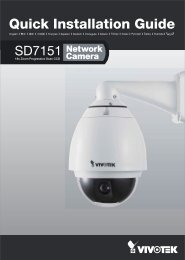
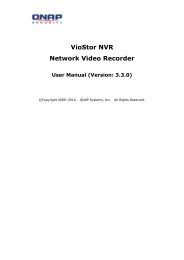
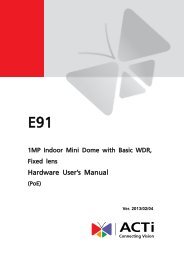
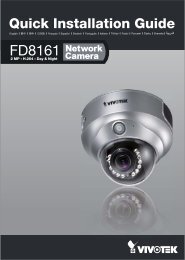

![Cover [IP7161]_Outline - Vivotek](https://img.yumpu.com/40460928/1/185x260/cover-ip7161-outline-vivotek.jpg?quality=85)
